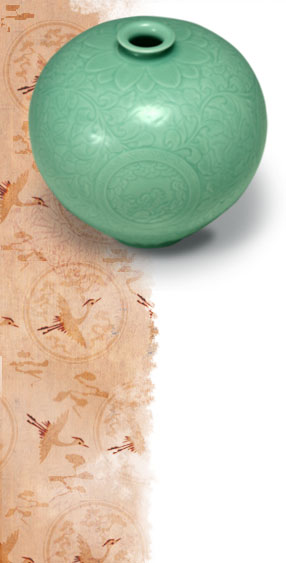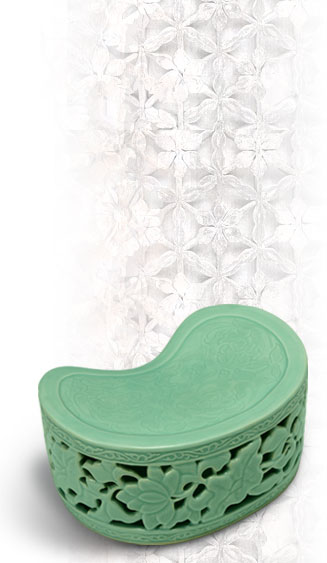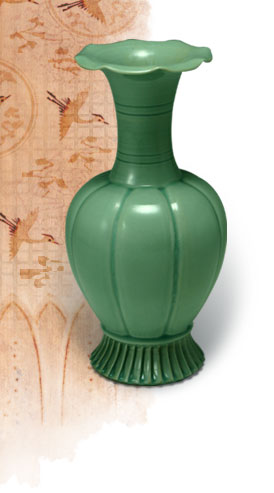 While
he was pursuing the dream of recreating Goryeo celadon, Cho came across
a researcher from While
he was pursuing the dream of recreating Goryeo celadon, Cho came across
a researcher from
 a porcelain company
based in Gwangju. He shared his knowledge of high-quality earth and stones
with a porcelain company
based in Gwangju. He shared his knowledge of high-quality earth and stones
with
 the company, and
he was invited to participate as a visiting researcher in the laboratory.
Here he was the company, and
he was invited to participate as a visiting researcher in the laboratory.
Here he was
 able to put forth his
ideas of experimentation with all imaginable combinations of different
components. able to put forth his
ideas of experimentation with all imaginable combinations of different
components.
 He
became more familiar with the different properties of minerals used in
ceramics through his He
became more familiar with the different properties of minerals used in
ceramics through his
 thorough
studies and repeated tests. The knowledge he gained from this experience
became the thorough
studies and repeated tests. The knowledge he gained from this experience
became the
 basis
for Cho’s later work in recreating Goryeo celadon. basis
for Cho’s later work in recreating Goryeo celadon.
 In
1963, he discovered a small portion of celadon glaze at a kiln
site of from the Goryeo Dynasty. In
1963, he discovered a small portion of celadon glaze at a kiln
site of from the Goryeo Dynasty.
 A
thorough study of earth and broken celadon pieces from a number of kilns
resulted in the finding A
thorough study of earth and broken celadon pieces from a number of kilns
resulted in the finding
 of
a unique mineral not found anywhere else. It was revealed that the mysterious
substance that of
a unique mineral not found anywhere else. It was revealed that the mysterious
substance that
 gave
Goryeo celadon its heavenly color was not a mystery after all; the key
to the quest was a cockle gave
Goryeo celadon its heavenly color was not a mystery after all; the key
to the quest was a cockle
 shell
commonly seen at the seaside. Cho found a mixture of clay and crushed
cockleshell in the corner shell
commonly seen at the seaside. Cho found a mixture of clay and crushed
cockleshell in the corner
 of
one kiln site. of
one kiln site.
Cho put his new finding into practice by making
the glaze with powdered shell. He fired one ceramic piece
after another, varying the kiln temperature and thickness of the glaze.
One morning, Cho held up one of his
finished works from the kiln against the morning sunlight when he saw
a piece of heaven, the color
that he was looking for throughout his life as a potter. He held it up
high and ran
out shouting elatedly, “It’s a celadon, true celadon!” as the joyous emotion
filled
his heart.
In 1966, Cho’s regeneration of Goryeo celadon
and its superb color was
approved and praised by a renowned art historian from the National Museum
of Korea, Choe Sun-woo, who encouraged Cho to continue with his pursuit
of
perfection. These words of support and encouragement became the driving
force for Cho’s continued effort to realize his dream.
After his celadon glaze was celebrated by the
public, he built his own kiln
and named it “Mudeungyo,” or, “The Kiln of Mudeung Mountain.”
Cho continued his pursuit of recreating Goryeo celadon while he became
a
 renowned
potter in international circles by participating in the Osaka International renowned
potter in international circles by participating in the Osaka International
 Exhibition
and Dallas World Expo. His celadon works have been sold in Europe, Japan,
and the U.S. since 1973. Exhibition
and Dallas World Expo. His celadon works have been sold in Europe, Japan,
and the U.S. since 1973.
 Cho
was not satisfied by mere momentary fame, however, and continued
to strive to realize the form of perfection in Cho
was not satisfied by mere momentary fame, however, and continued
to strive to realize the form of perfection in
 Goryeo
celadon. The discovery of a 12th-century celadon kiln site in 1973 by
a research team from the National Goryeo
celadon. The discovery of a 12th-century celadon kiln site in 1973 by
a research team from the National
 Museum
of Korea gave Cho the real answer. The broken celadon ceramic pieces from
the Gangjin site were evidence Museum
of Korea gave Cho the real answer. The broken celadon ceramic pieces from
the Gangjin site were evidence
 that
this was where the best of Goryeo celadon was once made. In 1977, Cho
lead the Celadon Recreation Committee to that
this was where the best of Goryeo celadon was once made. In 1977, Cho
lead the Celadon Recreation Committee to
 build
a new kiln in Gangjin based on the knowledge and experience gained from
the excavation of hundreds of kiln sites. build
a new kiln in Gangjin based on the knowledge and experience gained from
the excavation of hundreds of kiln sites.
 On
December 27, 1977, the fire of the Goryeo Celadon kiln in Gangjin
was lit once again after 600 years of On
December 27, 1977, the fire of the Goryeo Celadon kiln in Gangjin
was lit once again after 600 years of
 abandonment.
The nation’s eyes were turned to this small town, and the people’s hearts
beat as one in excitement abandonment.
The nation’s eyes were turned to this small town, and the people’s hearts
beat as one in excitement
 with
those of the potters. The door of the kiln surrounded by hundreds of eager
spectators was opened on with
those of the potters. The door of the kiln surrounded by hundreds of eager
spectators was opened on
 February
3, 1978, and the celadon pieces revealed themselves in divine light one
after another. The color of the February
3, 1978, and the celadon pieces revealed themselves in divine light one
after another. The color of the
 sky,
the mysterious heavenly color from the legend, was recreated on earth.
One would have been good enough, sky,
the mysterious heavenly color from the legend, was recreated on earth.
One would have been good enough,
 but
32 out of the 200 works fired inside the kiln came out as perfect resurrections
of Goryeo celadon. but
32 out of the 200 works fired inside the kiln came out as perfect resurrections
of Goryeo celadon.
 Potters
of today came in contact with their ancestors from almost a millennium
ago through the successful rebirth Potters
of today came in contact with their ancestors from almost a millennium
ago through the successful rebirth
 of
Goryeo celadon. The history of celadon ware in Korea was restored by Cho
Ki-jung, who devoted his life to of
Goryeo celadon. The history of celadon ware in Korea was restored by Cho
Ki-jung, who devoted his life to
 finding
the secret behind the color of peace and serenity for the human soul.
Cho Ki-jung not only successfully finding
the secret behind the color of peace and serenity for the human soul.
Cho Ki-jung not only successfully
 recreated
the world’s most beautiful ceramic ware but also opened a new page in
the history of ceramics by recreated
the world’s most beautiful ceramic ware but also opened a new page in
the history of ceramics by
 continuing
the spirit of true craftsmanship that was lost for nearly one thousand
years. continuing
the spirit of true craftsmanship that was lost for nearly one thousand
years.
View the master's works |

















